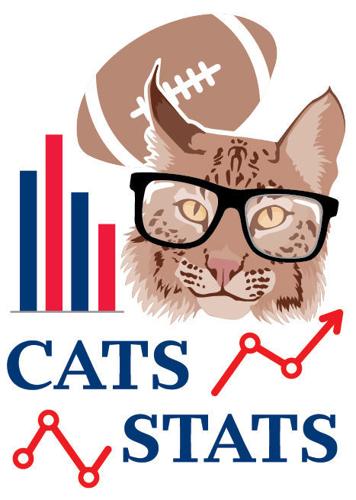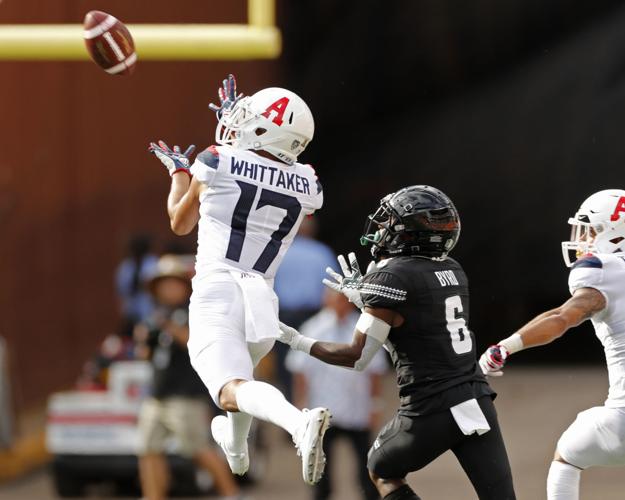Beware the small sample size.
Arizona and Texas Tech, who meet Saturday night at Arizona Stadium, each have played only one-sixth of their schedule. They have faced opponents – at least one in the Wildcats’ case, two in the Red Raiders’ case – who aren’t of the caliber they will face the rest of the season.
Consequently, you can read only so much into the statistics Arizona and Texas Tech have accumulated thus far. Some might be meaningful. Some likely are not. Others fall somewhere in between.
With that in mind, let’s examine four stats that could determine the outcome of the first matchup between the schools since 1989. In the process, we’ll also try to figure out what’s real and what isn’t.
Third-down defense
This is expected to be a high-scoring game. The over/under opened at 71.5 points and has been bet up to 77.5 — the largest figure across the Week 2 FBS slate, per VegasInsider.com.
If it plays out that way, third downs will be critical.
“The goal is to get off the field on third down for both teams,” UA coach Kevin Sumlin said.
One team has been more proficient at that than the other so far. Texas Tech’s opponents have converted only 4 of 31 third downs, or 12.9%. That puts the Red Raiders at No. 2 in the country.
Additionally, Texas Tech has forced three-and-outs on 55.6% (15 of 27) of opponents’ drives.
It’s hard to tell whether this is a blip or a true indication of a turnaround because the Red Raiders have a new coaching staff. Texas Tech ranked 57th nationally at 37.7% last year. Utah State – under current Tech coach Matt Wells and defensive coordinator Keith Patterson – ranked 16th at 33.0%.
Arizona has started off poorly in an area that’s been a point of emphasis since Marcel Yates arrived in 2016. UA opponents have converted 56% of their third downs, which ranks 127th nationally.
After Hawaii went 5 for 10 in the opener, NAU started 2 for 8 last week. But from the last drive of the second quarter on, the Lumberjacks converted seven straight third downs. That’s concerning under any circumstances.
Although the figure had fallen each year entering 2019, the Wildcats have yet to hold their opponents under 40% on third down for a full season under Yates.
Third-down completion percentage

Texas Tech quarterback Alan Bowman has completed 71.7% of his passes this season. Last year, his 69.4% mark was the best by a Red Raiders quarterback since 2012.
This is the flip side of third-down defense. Which quarterback can make the throws that move the sticks?
Prolific Texas Tech sophomore Alan Bowman is a more accurate passer, in general, than UA senior Khalil Tate. Bowman has completed 71.7% of his passes this season – a slight improvement from last year’s 69.4% mark, which was the highest by a Red Raiders QB since 2012 (minimum 300 attempts).
Tate is at 64.3%, which is 8 percentage points higher than last season and would represent a career high. (Yes, we know, sample size. He isn’t going to face NAU every week.)
But it’s worth noting that Tate’s 82.4% mark against the Lumberjacks was better than he did in any game last season. Tate didn’t exceed 65% until the 10th game of the year, against Colorado. It was one of only four times he topped 60%.
The accuracy gap between Bowman and Tate shrinks on third down – and especially on third and long.
Bowman has a 57.1% completion rate on third down over the course of his Texas Tech career. Tate is at 52.4% under Sumlin and Noel Mazzone.
On third-and-6 or more, Bowman’s percentage falls to 48.2. He’s just 2 of 8 for 12 yards in those scenarios this season.
Tate’s rate plummets to 41.5% on third-and-6 or longer since the start of last season. He’s 5 of 11 (45.5%) so far this year.
The 2019 percentages fall into the small-sample-size category. But it would appear that the best plan of attack for both defenses is to force the opposing QB into third-and-long. The one advantage Tate might have in those situations is that he’s more apt to convert with his legs.
Turnover margin

UA cornerback Jace Whittaker makes one of his two interceptions in the seasnon opener against Hawaii.
Remember that Sumlin line about the importance of getting off the field on third down? This is what he said next: “And who’s gonna hang on to the ball.”
This one is especially interesting, because the turnover totals so far scream regression.
Arizona is tied for first in the nation with a plus-6 turnover margin. The Cats have one fewer interception – six – than they had all of last season. Senior cornerback Jace Whittaker already has three.
“I expect that out of Jace,” fellow corner Lorenzo Burns said.
That’s a nice compliment, but neither Whittaker nor the Wildcats can be expected to keep up that pace. Many studies show that turnovers are subject to a degree of luck. The numbers tend to regress to the mean over time.
Which brings us to Texas Tech’s defense, which has yet to record a takeaway this season. The Red Raiders haven’t so much as forced a fumble.
That’s as unlikely to continue as Arizona’s torrid turnover rate – especially when you factor in the style of defense Patterson likes to run.
In his lone season at Utah State, the Aggies shared the FBS lead with 32 takeaways. In his first year at Arizona State, in 2014, the Sun Devils tied for first in the Pac-12 with 14 interceptions and ranked third with 27 total takeaways.
It’s more likely than not that the turnover trends on both sides won’t continue for long.
Punting average and field position
There probably won’t be much punting Saturday night. But if there is, Texas Tech appears to have a sizable advantage that could significantly impact field position.
Austin McNamara — who attended Gilbert Highland High School and held an offer from Arizona — is averaging 47.8 yards per punt, which leads all freshmen nationally. The Red Raiders’ 47.22 net average ranks fifth in the country.
UA senior Matt Aragon and freshman Kyle Ostendorp have struggled so far. Their combined gross average is 35.6 yards. Their combined net average of 34.29 is tied for 111th nationally.
The difference in net average is nearly 13 yards — a massive number in a game that’s expected to be tight. (Texas Tech was favored by two points as of Wednesday afternoon.)
In part because of the punting issues, Arizona has had worse average starting field position than its opponents in each game. Hawaii had a 6-yard advantage despite turning the ball over six times.
Texas Tech played Montana State to a draw in average starting field position in Week 1 and had an edge of almost 11 yards on UTEP last week despite not forcing a turnover.
Do we have enough of a sample size to definitively say that McNamara is 10-plus yards better than Arizona’s punters? No. But even if it’s half that, it could make a difference.
Remember: Arizona came within a single yard of tying or beating Hawaii on the last play of the game.








